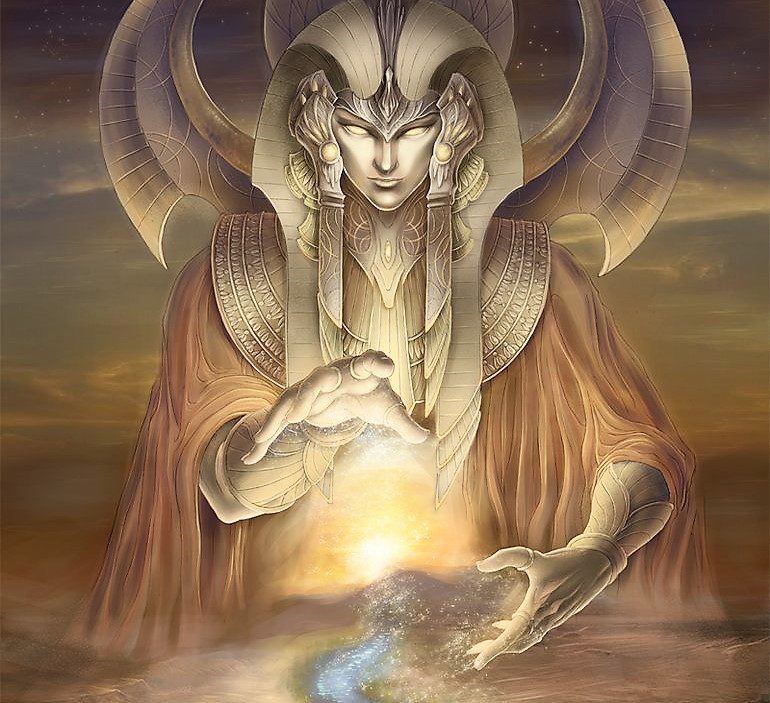Reading Time: 6 minutes
The Nile which is one of the longest rivers in the world passes through nine countries in Africa before it reaches Egypt and the Mediterranean Sea. It covers from start to finish a length of 4000 miles, flowing south to north, of which only 900 miles actually go through Egypt. The origins of this legendary river are quite obscure and steeped in mystery. Conjectures apart, nobody actually knows for sure where it actually springs from, even today. Several attempts since ancient times have been made to trace its path to its origin, says Sreelata. She talks about its history and politics. A Different Truths exclusive for the Special Feature on Africa.


Hail to thee, O Nile! Who manifests thyself over this land, and comes to give life to Egypt! Mysterious is thy issuing forth from the darkness, on this day whereon it is celebrated! (Internet Ancient History Sourcebook-Hymn to the Nile, c. 2100 BCE-)
Think ‘Nile’ and Egypt springs instantly to mind. Add to it the Pyramids, the Sphinx, the wealth and mummified remains of the Pharaohs to make the Nile Basin an awe-inspiring and exciting playground for every archaeologist.
History has always glorified the Nile and extolled the virtues of the ancient civilisations it nurtured along its banks. The fertility of its lands, the beauty of its people and the prosperity of its culture completely entwined with the fortunes of this famed river that finally empties itself into the Mediterranean Sea stand testimony to its greatness.
While ‘Nile’ is a spinoff of the Greek word ‘nelios’ meaning the ‘river valley’, in Egyptian the Nile is ‘Iteru’. It simply means ‘Great River’.
So since Egypt itself is considered ‘a gift of the Nile’, one could well be forgiven if one were to believe that the Nile waxed and waned only in Egypt. But in reality, the Nile which is one of the longest rivers in the world passes through nine countries in Africa before it reaches Egypt and the Mediterranean Sea. It covers from start to finish a length of 4000 miles, flowing south to north, of which only 900 miles actually go through Egypt.
The origins of this legendary river are quite obscure and steeped in mystery. Conjectures apart, nobody actually knows for sure where it actually springs from, even today. Several attempts since ancient times have been made to trace its path to its origin.
Even the Roman Emperor Nero’s men could go no further than the swamps of Sudan. Diogenes, a Greek merchant from the east coast, noted the presence of some great lakes and large imposing mountains in central Africa during his travels. From this and other narratives the great Egyptian-Greek geographer Ptolemy in the 2nd century AD deduced that the Nile’s source must indeed be from those great lakes at the foot of the ‘Mountains of the Moon’. He soon came up with a rough map.
However, the hostile terrain and the inimical tribes that lived among the bushes rendered it next to impossible for other ancient explorers to go any further.
Then in the 1800s the Europeans discovered Africa.
In their scramble to lay their greedy imperialistic paws on her they were aided and abetted by many of their intrepid explorers.
So while David Livingstone was busy exploring the Congo and encountering H.M. Stanley, a British expedition, in 1857 (and a later one, in 1862) headed by a John Speke using Ptolemy’s 2nd century map discovered the great lake –Lake Victoria.
He declared that the Nile originated from a waterfall off Lake Victoria he named Ripon Falls. Hotly challenged by others on the expedition he died a mysterious death. So it was left to the same famous Stanley – who circumnavigated the lake in 1875 – to prove Speke right.
At Jinja, near Kampala, in Uganda, an obelisk marks the spot where Speke first saw the waters of the great lake hurtling down and start on their long journey. While this was universally accepted as the source it ended neither the debates nor the conjecturing. For it threw up another question- what waters fed the Lake Victoria? No one knew since no one had dared or managed to go beyond.
Then, in 1934, a German explorer, Burckhardt Waldeker, discovered the Kagera River among the hills of Burundi, further south. He believed it was the Kagera waters that fuelled the Victoria. A small pyramid apparently marks the source. But the matter still did not end there.
In March 2006, a British-New Zealand team called the Ascend the Nile with all the latest – GPS coordinates – technology decided to brave all odds and unravel this mystery and put it to rest once and for all. Tackling swamps, crocodiles, hippos and even death (their team leader was killed by Ugandan rebels) they finally managed to reach what they now believe is truly the longest farthest source of the Nile.
Deep in the Nyungwe forests of Rwanda in a muddy hole. But considerably short of Waldeker’s bubbling spring in Burundi.
Even so, the National Geographic Society is prepared to believe that there could be two sources – one in Rwanda and the one in Burundi. Or who knows it could even still be in the snowcapped peaks of Ptolemy’s ‘Mountains of the Moon’ – said to be the Ruwenzori ranges on the Uganda-Congo borders by Stanley himself, in 1889.
So while the largest source is undoubtedly Lake Victoria what the ‘only’ source actually is or whether there are more is still open to question. That perhaps is the reason for the Nile’s aura of romanticised mystique.
And that is also perhaps the reason why when we landed up in South Sudan and found ourselves living on the Nile front, we realised that there was perhaps more to the river Nile than Egypt.
Juba the capital of the world’s youngest- strife ridden-nation sits right on the banks of the same legendary Nile. Only here it is called the White Nile and its origins are yes the same – from Speke’s Lake Victoria or now perhaps beyond.
Lake Victoria is a massive freshwater tropical lake that is 68000 sq kms wide spread over Uganda (45%), Kenya (6%) and Tanzania (49%).
From Jinja (Uganda) the river flows to a Lake Kyoga as the Victorian Nile then reaches another lake called Lake Albert when it becomes the Albert Nile. As it enters South Sudan at Nimule, the Nile is known as the Bahar al Jabal or the river of the mountain (Mountain Nile).
It then rumbles through to be almost entirely swallowed up by the great swamp Al Sudd in Sudan and then streams out into Lake ‘No’ where it merges with yet another tributary Bahr el Ghazal (river of gazelles) and flows out quietly as the White Nile (Bahr el Abyad) on its way to Khartoum the capital of the north-undivided Sudan.
It is here in Khartoum- the river Nile as we know it finally begins but again only after it merges with another shorter tributary, the Blue Nile, which comes down from Lake Tana (3600sq kms) in the Ethiopian Highlands into Khartoum. Therefore, the White Nile flows in from East Africa, while the Blue Nile flows from Ethiopia.
So the Egyptian Nile is actually a combination of two tributaries – the White Nile (3700kms) with its many sections and the Blue Nile (1450 kms).
Due to its white clay suspensions, the White Nile came to be known as the White Nile while the colour of its black silt gave the Blue Nile its name. It is the waters of the Blue Nile that go to make Egypt’s Nile, the font of all fertility, prosperity and livelihood in the Egyptian Nile Valley.
The credit for discovering the source of the Blue Nile goes to a Scottish explorer James Bruce, who did so almost 85 years (1770) before Speke found Lake Victoria – although it was mentioned in dispatches by a Spanish missionary Pedro Paez as early as 1618 and reached by another Portuguese missionary J. Lobo, in 1629.
As I watch the White Nile (Bahar al Jabal-Mountain Nile) I am struck by its constancy of its flow. No highs no lows ,just a ceaseless coming together of little ripples running along in no seeming hurry to meet anyone or anything let alone its partner in waiting – the Blue Nile.
It is beautiful on the river front. The fruit laden mango trees sway in tandem with the papyrus rushes as the monsoon winds threaten to blow us away.
Occasionally, broken down rusty tin cans that pass for barges emerge out of the horizon ferrying equally shabby cargo to an even more dilapidated patio beyond, which is the South Sudan Port. It leaves in its wake oil and larger ripples.
The swarming fish barely seem to move while the lurking crocodiles leave no trace of having been there at all. The little ones we were warned might pop up but otherwise the Nile’s famous crocs exist only in our imagination.
There is a strange quiet that is all pervasive on the banks of this river Nile that flows through Juba. Amidst all the turmoil of unending civil wars on its banks the river appears calm and untroubled by the unhappiness and strife around it.
As it weaves its way down from Burundi or Rwanda, the Congo, Tanzania, Kenya, Uganda, South Sudan and heads towards North Sudan, Ethiopia and Egypt one realises that it passes through the very heart of Africa.
An Africa made famous by its great river.
Photos from the Internet
#Rwanda #Congo #Tanzania #Kenya #Uganda #SouthSudan #Africa #SpecialFeature #DifferentTruths














A river of colours,black,white blue. An enigma,more reasons to be drawn to.
Regards